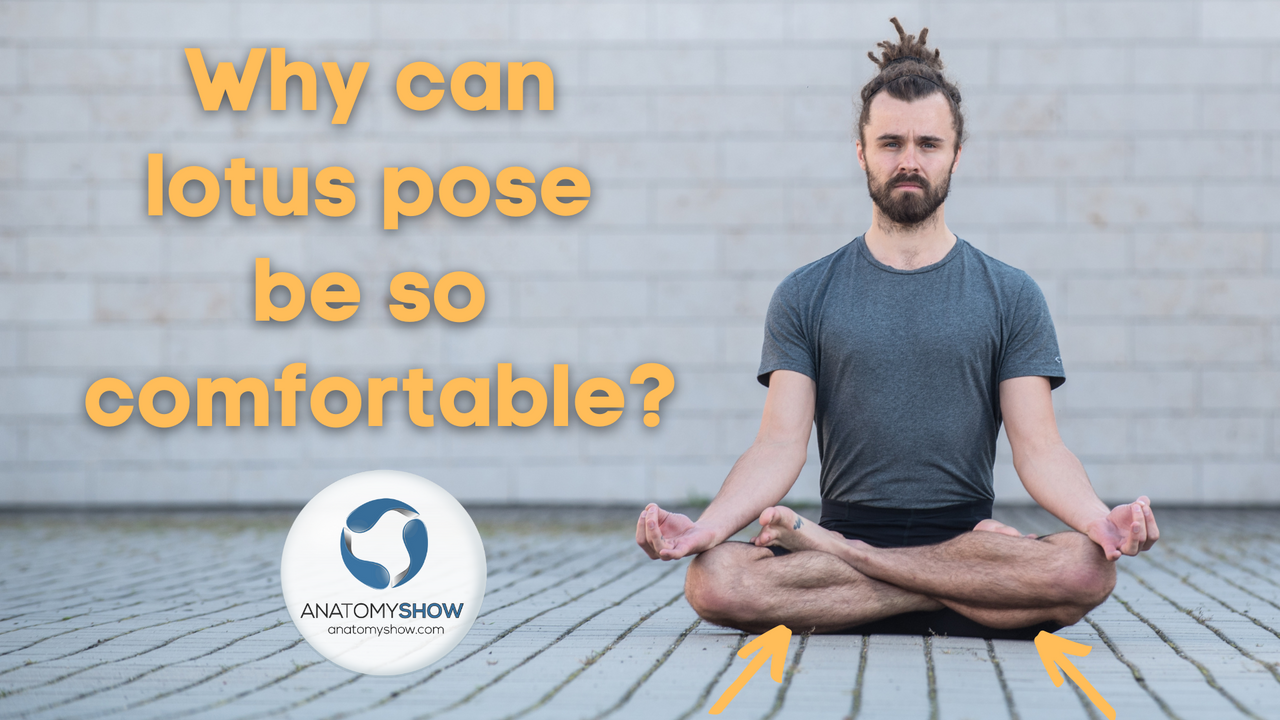
Why Can Lotus Pose Be Comfortable? (for some)
Dec 06, 2022Lotus pose, or padmasana, often appears in texts and imagery as the essential seated posture for meditation or pranayama (breathing practices). Lotus pose is of course found in various asana (posture) practices of many styles of yoga.
In posture practices, lotus pose is not held for significant length of time and only forms a small part of the postures practiced during that session.
When practicing meditation or pranayama, the physical posture changes very little. So the posture you choose to sit in for that practice is significant when it comes to how comfortable you will be over the duration of the seated practice.
This blog pose examines what can make padmasana so comfortable, relative to other seated postures. The technique and anatomical requirements for getting your body into lotus posture are only described briefly.
Now, lotus pose is not an easy pose for many people. So much so that in one studio I was teaching, everyone struggled to come even close. Of course lotus pose is not a ‘must do posture’ or a qualifier before you can say ‘I can do yoga’.
Because I was happily sitting in lotus at times during various practices, my name in that school became ‘pretzel Chris’. While it helped distinguish me from the other Chris’s around, it highlighted the challenges associated with padmasana.
What do we need to know about padmasana anatomically?
Lotus pose is a posture involving both entire legs and hips.
Essentially lotus pose is a strong outward rotation of the leg at the hip while the hip / thighbone is in abduction.
Your individual body shape, mostly bones and habits, give you an starting point and set of restrictions.
It is important to note that lotus pose is not about the knees. From experience I know for many people, this posture can be felt (often uncomfortably) in the knees.
As a general rule, knees do not like to bend sideways, not under pressure, and not for longer times. Any deficiency in external rotation of the thigh and leg at the hip joint will have to be compensated for somewhere. That’s where your knee comes in. But not in a good way. The ankle and top of foot, especially of the leg that is folded in first, can be a further source of discomfort. Relative insufficient hip mobility will ask for more stretch from the tendons and fascia of the top of the foot as it clings on to the thigh of the other leg.
Take note! If the knee hurts in lotus pose, you might like to address this and change something in your posture.
Let’s return to the comfort that can be had when sitting in lotus pose. Where and why does this happen?
Or asked from a practitioner’s perspective: Why is lotus pose depicted and described as the meditation or pranayama posture of choice?
If you ever tried sitting in any other posture on a hard floor for some time, the answer quickly becomes obvious.
Other seated postures have one or more bones pressing against the ground. These could be either the sitting bones and / or the outer ankles. Maybe the side of the foot, the outer knee, or the shin bone and and top of foot. After a little while when sitting on these bony areas, they start complaining about too much pressure.
Often we can force, or will ourselves to remain in that position and continue to be calm and ‘meditate’. In the end, physical discomfort can be quite distracting.
In lotus pose, on the other hand, we avoid contact of the bones with the floor. Because of that pretzel shape with elevated feet and ankles, along with a slightly forward tilted or neutral pelvis, all contact with the ground is via thigh muscles and maybe some lower parts of the glutes / the butt muscles.
In a modern world we use soft, dense yoga mats, foam block, cushions, bolsters and many other props to sit comfortably. Not too long ago, or in other areas of the world, these props might not be available. Sitting on the floor was just that - Sitting directly on the actual floor. Likely somewhat hard and possibly uneven.
In these situations, lotus pose, if accessible for that particular person / body, can be invaluable. Our leg muscles provide our own cushion.
As mentioned above, padmasana in itself can present with serious challenges to feeling comfortable. With suitable anatomy and adequate practice, there is a point at which we can access sufficient mobility within the hip joint to move into lotus pose and remain there comfortably for some time. In that situation, the knees, ankles or sitting bones are not sending signals of discomfort any more, leaving us less concerned with physical challenges to attend to breathing or meditation.
With padmasana, sitting becomes easy on any surface, because we provide our own cushion of muscles to sit on.
Learn more about the anatomy needed for padmasana in your moving body with the AnatomyShow ‘pelvis course’. Deepen your understanding of how to practice and teach yoga better.
Do you know enough about fascia and fascia connections to know the reasons for practicing every posture?
Include the advantage of real functional movements into your life and learn now how fascia based yoga anatomy can help you.
If you’re a teacher, you can gain greater confidence in teaching safely.
Get the course and qualify for Yoga Alliance continuing education credits.
Don't miss what's happening!
New posts, education, and movement ideas delivered to your inbox.
We hate SPAM. We will never sell your information, for any reason.

